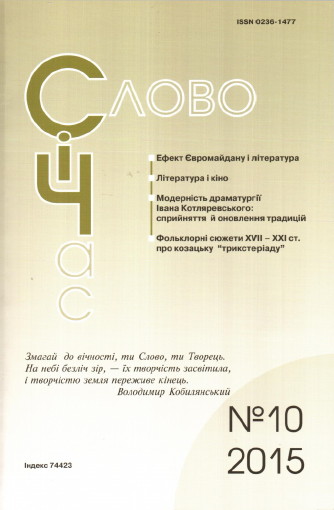Slovo i chas
Slovo i chas [«Слово і час»; Word and Time]. A scholarly journal of literary scholarship, history of literature, and literary criticism. It was originally established in Kyiv in 1957 under the name Radians'ke literaturoznavstvo as an organ of the Institute of Literature of the Academy of Sciences of the Ukrainian SSR and of the Writers' Union of Ukraine. Its precursor was a series of proceedings of the Institute of Literature also titled Radians'ke literaturoznavstvo (1937–57, 19 vols). The journal was published first as a bimonthly (1957–64), then as a monthly (January 1965–December 2019), and again as a bimonthly (since 2020). It was renamed Slovo i chas in 1990 (thereafter popularly referred to as SiCh). Its chief editors have been Oleksander Biletsky (1957–61), Ihor Dzeverin (1961–72 and 1980–89), Viktor Bieliaiev (1973–79), Vitalii Donchyk (1989–2000), Lukash Skupeiko (2000–19), Ihor Nabytovych (2020–24), and Mykola Zhulynsky (since 2024).
As a result of the change in editors during the Soviet times the quality of the journal Radians'ke literaturoznavstvo noticeably deteriorated in the 1950s. Its large section dedicated to literary theory became limited to fatuous theorizing on the issues of socialist realism. In addition to traces of a propagandistic Communist Party-minded tone in the articles on literary history and literary criticism, there was a marked absence of papers on contemporaneous trends in world literature and on the relationship between the Ukrainian literature and foreign literatures. The journal further deteriorated with the intensified persecution of the early 1960s, which resulted in a narrowing of the issues permitted for discussion and in many authors’ being prohibited from publishing their work in the journal (eg, Ivan Dziuba, Ivan Svitlychny, Yevhen Sverstiuk, V. Ivanysenko). The major ideological shift occurred with the resolution by the Central Committee of the Communist Party of the Soviet Union titled ‘On the Literary and Art Criticism’ (1972), which led to the less frequent use or virtual disappearance of some ‘non-ideological’ sections, such as ‘Publications and Announcements.’ The quality of Radians'ke literaturoznavstvo, in fact, was indicative of the general deterioration in Ukrainian literary scholarship caused by the gradual loss of scholars of the old school (eg, Serhii Maslov, Oleksander Biletsky, Pavlo Popov, Yevhen Nenadkevych), who were gradually replaced by scholars educated in the Soviet system. Among the latter group there were few who could be considered authorities in Old Ukrainian literature, and for that reason the scope of the journal was reduced to studies of 19th- and 20th-century literature; typical contributors were those who specialized in the relationship between Ukrainian and Russian literature (Nina Krutikova) or in the theory of socialist realism (Mykola Shamota). The dynamics of the journal’s circulation in those years was as follows: 1957—3,000 copies, 1958—5,600, 1959—3,400, 1960—2,320. The circulation remained at the level of 2,000 to 3,000 until 1982 and only in 1969 and 1971–73 it exceeded it by 200–500 copies. From 1982 to 1989, the circulation did not rise to the 2,000 mark due to the fact that the Soiuzdruk—a state monopolist in the distribution of periodicals—refused to take the journal for retail sale.
The democratization and policy of glasnost announced by Mikhail Gorbachev in 1985, which improved the quality of many other literary journals, had some effect also on Radians'ke literaturoznavstvo. The journal began to publish materials about the Ukrainian studies abroad, articles by Ukrainian diaspora scholars, and studies of writers who had long been ‘banned,’ for instance, those belonging to the so-called ‘Executed Renaissance’ of the 1920s. The journal’s authors now included scholars and critics of younger generations that would redefine the study of Ukrainian literature in the next decade; they included Anatolii Makarov, Mykola Zhulynsky, Viktor Morenets, Viacheslav Briukhovetsky, Yurii Kovaliv, Tamara Hundorova, Yevhen Nakhlik, and others. However, a substantial shift in the editorial policy of the journal and the quality of published materials materialized only in independent Ukraine, after the journal was renamed Slovo i chas.
With the change of a title in 1990 came the change of journal’s scope: while it remained a journal of literary theory, history of literature, and literary criticism, it also turned to new areas, such as art history, sociology of literature, teaching literature in schools and universities, journalism, non-fiction, politics, and religion. The circulation of the journal in 1991–93 increased from 7,000 to over 9,000. From a strictly scholarly journal SiCh evolved into a general interest periodical with the focus on cultural studies. However, over the next decade SiCh returned to its erstwhile focus on academic literature studies. Since 2010 it has been published jointly by the National Academy of Sciences of Ukraine and the Institute of Literature of the National Academy of Sciences of Ukraine.
SiCh has around 40 regular sections, including a number of general mainstays (‘Ad fontes!,’ ‘Questions of Theory,’ ‘Taras Shevchenko studies,’ ‘Ivan Franko studies,’ ‘Twentieth-Century Literature,’ ‘Present-day Literature,’ ‘Foreign Literature,’ ‘Reviews,’ ‘Literary Criticism’), and also some more specific ones, such as those dedicated to philosophical issues (‘Logos’), gender studies, postcolonial studies, autobiography (‘About Time and Self’), archives (‘What Has Been Written Remains’), memoirs (‘From the Memory of Bygone Years’), sociology of literature (‘Sociological Service’), and art criticism (‘Temple of Muses’). The journal also publishes methodological materials for teachers (‘Literature Class’), charitable activities in Ukraine (‘Donors, Sponsors, and Benefactors’), discussions and polemics (‘Discussions’), and announcements and information (“Chronicle of Events”). Annually, every third issue of SiCh is devoted to the legacy of Taras Shevchenko. Some issues are fully devoted to the life and works of individual authors (for instance, the October issue in 2002 was devoted to Viktor Petrov-Domontovych). Systematic guide to SiCh was published for the period 1990–99 (2002). The journal’s online archive contains issues from 2003 to present.
The journal’s official website is: https://il-journal.com/index.php/journal
BIBLIOGRAPHY
Skupeiko, Lukash. ‘Naukova periodyka (“Radians'ke literaturoznavstvo,” “Slovo i chas”)’ in Visimdesiati i dali...: Korotka istoriia Instytutu literatury im. T.H. Shevchenka NAN Ukraїny (Kyiv 2010)
Serhiy Bilenky, Ivan Koshelivets
[This article was updated in 2025.]

.jpg)
.jpg)
.jpg)
